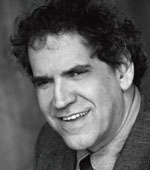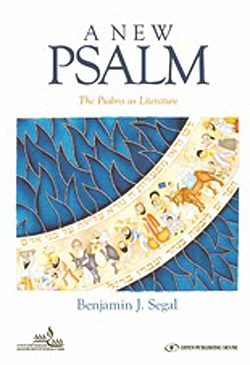A New Psalm: A Guide to Psalms as Literature by Rabbi Benjamin Segal; Gefen Publishing House (2013); ISBN-10: 965229618X; Price: $31.29 (on Amazon).
By Rabbi Michael Leo Samuel

 CHULA VISTA, California — Rabbi Benjamin Segal’s new commentary, A New Psalm: The Psalms as Literature is an excellent medley of numerous thoughts that Judaic commentaries have expressed on the Psalms for many centuries. Rabbi Segal has written a translation on Song of Songs: A Woman in Love as well as other books pertaining to the Land of Israel and Zionism.
CHULA VISTA, California — Rabbi Benjamin Segal’s new commentary, A New Psalm: The Psalms as Literature is an excellent medley of numerous thoughts that Judaic commentaries have expressed on the Psalms for many centuries. Rabbi Segal has written a translation on Song of Songs: A Woman in Love as well as other books pertaining to the Land of Israel and Zionism.
The author asserts:
- In this commentary, one discovers not poets who were pietists, but rather people, born of a society whose worldview and actions were often in conflict with the dictates of the single God who is both moral and just. It is the form and literary finesse of this poetry that allows one to discover not only the praise, but also the doubts, anger and angst. I invite the modern reader to discover in
A New Psalm
- these gifted individuals who lived with the same questions and doubts that we have today.”
The author is absolutely on target. Unlike the great philosophical and theological works of history, the Book of Psalms has a unique distinction in that they are not so much theological reflections written about God; they are, rather, records of people’s spiritual encounters with God. As God’s Word, believers of the Bible—Christian and Jewish—have long believed that the Spirit of the Divine communicates through these ancient prayers composed thousands of years ago by Israel’s poets.
The Psalmists were not indifferent to the problems of theodicy or the problems articulated by the modern age concerning God’s apparent absence from the human arena. Many of the Psalms reflect the cries of lament expressed by people who faced unspeakable evils in their days. The authors did not shy away from speaking to God about their crises in faith. Yet, they did also bear witness to God’s healing power and embraced the possibility and hope of personal and national renewal. The Psalms frequently remind us that divine healing facilitates a renewal of body and soul.
The multi-dimensionality of divine and human communications is evident in each of the Psalms. The psalmists speak about longings of God and humankind for one another. They present visions of hope and the beauty of Creation spirituality that suffuses the natural order. They contain admonitions concerning the problem of human evil.
For our ancestors, the Psalms constituted the very first Siddur (Prayer book) of ancient Israel. There was scarcely a religious service in the days of the Temple that did not incorporate its verses. Over the millennium, the Psalms have formed an integral part of modern Jewish worship. Individuals have continuously evoked their words in moments of quiet meditation and soulful reflection. The words of the Psalms create a bridge that has united worshipers across the cascading movement of time.
Psalms inspire piety and spiritual mindfulness. The foci of the Psalms are God and human beings. They remind us about our collective and individual capacity for greatness; they remind us about the misery of human existence apart from the life of faith. In Israel’s darkest moments, the Psalms reminded her to hold fast to the reality that God is always close to the innermost human heart and is accessible at all times to prayer. In a God-centered reality, the Psalms teach us that there is no place void of the Divine Presence.
In the introduction, the author points out how the five books of the Psalms correspond to the Pentateuch—a tradition that dates back to the time of the Septuagint. Of the five books, only the first book contains the psalms that are associated with King David. The second and third book reflect Levitical families (who were the singers at the Temple) while the last two reflect the period of early monarchy. Evidence of a Documentary Hypothesis is also evident in certain Psalms. There is a group of “Elohist” Psalms (Psalms 42-83), where God appears more than “LORD” (YHWH). However, the vast majority of Psalms whereas YHWH is generally mentioned more frequently throughout the rest of the Psalms.
One of the chapters that deeply impressed me as I was reading his book, was his observations regarding how alliteration appears in the Psalms. Since I am presently finishing up my new book on Psalm 23, I was especially interested to see what Segal had to say.
Several interesting Hebrew alliterations in Psalm 23 serve to create conceptual nexus with each word’s counterpart. For example, רֹעֶה (rö`è) corresponds to רָע = rǎʿ (v. 23:4); v. 2 מֵי מְנֻחוֹת (mǎy menû∙ḥôt) corresponds to יַנְחֵנִי “He leads me” (v. 3) and הֵמָּה יְנַחֲמֻנִי “they comfort me” (v. 4); בִּנְאוֹת דֶּשֶׁא “lush green pastures” corresponds to דִּשַּׁנְתָּ בַשֶּׁמֶן רֹאשִׁי – “you anoint my head with oil” (v. 5); נַפְשִׁי יְשׁוֹבֵב “he restores my soul” corresponds to וְשַׁבְתִּי בְּבֵית־יְהוָה לְאֹרֶךְ יָמִים — and I shall dwell in the house of the Lord my whole life long (v. 6).[1]
In short, A New Psalm should appeal to anyone who is interested in a traditional but very modern exposition of the Psalms. The study of the Psalms will certainly help anyone who is interested in understanding the prayers that have inspired generations of worshipers. Incidentally, the book has some outstanding artwork interspersed with lovely pictures painted by David Sharir. His artworkadds a lovely aesthetic dimension to the book. The cover to A New Psalm is one of the nicest covers to the Psalms I have seen in years.
*
Rabbi Dr. Michael Leo Samuel, spiritual leader of Temple Beth Shalom in Chula Vista, is author of: Psalm 23: A Spiritual Journey (Kodesh Press, 2014), Birth and Rebirth Through Genesis: A Timeless Theological Conversation (Genesis 1:3) (Createspace 2010); The LORD Is My Shepherd: The Theology of the Caring God (Jason Aronson Inc. 1996).
[1] R. Benjamin J. Segal, A New Psalm: The Psalms as Literature (Jerusalem: Gefen Publishers, 2013), 107.
Pingback: Five stars plus for a book on Psalms - San Diego Jewish World